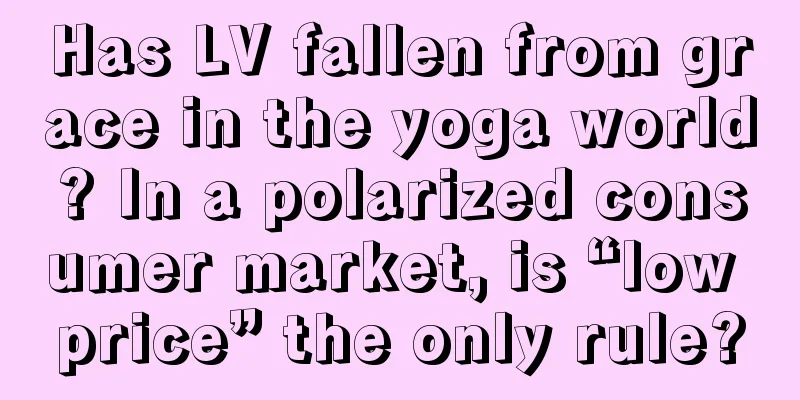Has LV fallen from grace in the yoga world? In a polarized consumer market, is “low price” the only rule?

According to the third quarter report recently released by lululemon, in the third quarter of 2022, lululemon's revenue and net profit both achieved different degrees of growth, but the current gross profit margin was 55.9%, lower than the average analyst expectation of 56.7%, and the operating profit margin fell by 20% compared with the same period in 2019. The gross profit margin also declined in the second quarter, from 58.1% in the same period of the previous fiscal year to 56.5%. In terms of inventory, the report showed that by the end of the third quarter, lululemon's inventory increased by 85% year-on-year to US$1.7 billion. As reflected in the capital market, although lululemon's market value has surpassed Adidas in all aspects, its stock price has fallen from US$387 at the beginning of the year to around US$316. Although the overall decline is still lower than that of the US stock market, it also reflects to a certain extent the market's expectations for lululemon's prospects. Judging from the data performance, it does not seem to be that exaggerated, and lululemon's performance is still remarkable. However, judging from the performance of some key data and the overall trend of the consumer market, lululemon's prospects are indeed full of challenges and uncertainties. Its challenges and uncertainties come from the continuous and rapid changes in the market competition environment on the one hand, and from lululemon itself on the other hand. The most critical point is the change in the overall consumer trend. Lululemon was founded in 1998. With a pair of yoga pants, it ranked 1128th on the "2022 Forbes Global 2000". Its market value exceeded that of Adidas, and it ranked first with a revenue growth rate of 49%. In just over 20 years, with a pair of yoga pants, it has achieved the market value level that Adidas and Nike took nearly 40 years to achieve. And it is just a single brand, which is definitely a dark horse in the sportswear industry. Just based on this, lululemon has established its market position. Lululemon is a very successful business case, a typical example of brand building in the new business era, and a product of the evolution of the consumer market to a specific stage. It has its own particularity and typicality. But at the same time, in the process of a relatively niche field evolving towards mass adoption, the brand itself and its products have to face various tests from changes in the market environment. 1. Three core elements make lululemon the king of the market segmentLet’s take a brief look at how lululemon started and rose. Image source: lululemon official Weibo 1) First of all, the birth of lululemon originated from the pain points of yoga sports equipment discovered by founder Chip Wilson. Yoga started to become popular in Europe and the United States in 1998. Chip Wilson believed that this sport would become a major trend. When sports brands such as Nike and Adidas focused on male-dominated sports, yoga, a female-dominated sport, would inevitably have a strong distinction, which meant market opportunities. However, the founder found that due to the lack of professional yoga equipment, there were no products on the market that were breathable, close-fitting, elastic, beautiful, and easy to care for. Many people chose to practice yoga in dance costumes, but dance costumes are not suitable for everyone. They are very picky about the wearer's figure, and the fabric of dance costumes is too thin. When doing stretching exercises, the skin will be exposed, and excessive sweating is also embarrassing, including the "camel toe" problem. Seeing these pain points, Chip Wilson also saw business opportunities, and lululemon was born. It focuses on yoga and becomes a pioneer in functional yoga pants. Through fabric research and development, it solved the problems of transparency and camel toe in yoga pants, and by seaming outwards, it solved the problem of rashes caused by friction during exercise. For example, the independently developed LUON patented fabric and Silvere scent anti-odor technology make the product softer, more comfortable and fit. At the same time, the unique design solves the problem of stretchability of yoga pants during exercise, ensuring that women will not expose their skin when doing any yoga poses, especially solving the problem of "camel toe". Compared with dance clothes, Lululemon's yoga pants highlight women's body lines more. Lululemon is positioned in the mid-to-high-end market, so in terms of price, lululemon's yoga pants are more than twice as expensive as those from brands like Nike and Adidas. Its user profile is a "new middle-class" female aged 24 to 35, single or engaged, childless, highly educated, sports-loving, professional, with an annual income of about $80,000 and a pursuit of fashion. This group has high income, strong purchasing power, pays more attention to the quality of life, has higher brand loyalty, and has higher demands for product quality and fashion. These characteristics determine a very clear and unique positioning for lululemon. Also, one thing that needs to be noted here is that lululemon does not limit its brand positioning to yoga. It is also a fashionable daily wear, and wearing yoga pants as outerwear has indeed become a trend. 2) Secondly, in terms of channels , since 2011, franchise stores have been completely cancelled, focusing on offline direct sales and e-commerce, and selling products through direct stores, DTC (direct to consumer) channels and other channels. The vertical retail model with direct stores and DTC channels as the core has contributed more than 90% of lululemon's revenue. Unlike the wholesale model of sales through distributors, there is no "middleman" link, and it is directly facing end consumers. Lululemon's approach is obviously closer to consumers. This is an important condition for lululemon to carry out unique social media marketing, and it also strengthens lululemon's pricing power for end products. 3) The key to lululemon's rapid growth, its greatest success, and a highly respected strategy in the Internet business era, is social marketing + user experience. Lululemon's rapid rise is inseparable from its unique community marketing model with offline as the core and online as the auxiliary. Unlike other sports and leisure brands, lululemon rarely signs celebrities as spokespersons, but uses KOLs for precise community marketing, and focuses on the consumer experience of stores (such as setting up yoga courses in stores), yoga itself, and promotes elements such as brand ambassadors and life concepts, making community marketing an activity that everyone can participate in. Through these methods, an emotional connection beyond the buying and selling relationship is established with users, prompting users to become fans of lululemon and willing to continue to consume at lululemon. This marketing method has allowed lululemon to accumulate a large number of fans in a short period of time, and lululemon has also become a social tool. Image source: lululemon official Weibo From products to channels and marketing, lululemon's business strategy is worth learning from. 2. Quality and price do not match, consumers complain that "supply chain dependence" is the biggest hidden dangerOver the years, lululemon has encountered many problems and has been questioned a lot. At the opening ceremony of the Beijing Winter Olympics, the Canadian team wore lululemon sportswear. With the popularity of the Winter Olympics, lululemon's Olympic series products sold out and the official website crashed. However, in May 2022, lululemon was fined more than 81,000 yuan and had more than 23,000 yuan of illegal gains confiscated by the Beijing Xicheng District Market Supervision Administration because the filling volume of its Navigation men's down vest did not meet national standards, which violated Article 50 of the Product Quality Law (adulteration or counterfeiting of products, passing off fake products as genuine ones, passing off inferior products as good ones, or passing off unqualified products as qualified ones). As early as 2018 and 2019, Lululemon was administratively punished for "unqualified products passing off as qualified products", with the two fines totaling nearly 200,000 yuan. In addition, lululemon has been repeatedly complained and exposed by consumers for suspected price fraud. For example, some consumers said that after purchasing through online channels using the discount mechanism, they found that the price they paid was higher than the actual tag price when they received the goods. Even physical stores have seen cases where the actual payment was higher than the tag price. On the Black Cat Complaints page, many consumers said that the fabrics used in the lululemon products they purchased online and the same products in offline stores were different, that the prices in the online flagship store were more expensive than those in offline stores, etc. In early June 2022, a consumer complained on Xiaohongshu that he spent more than 3,000 yuan to buy two sets of lululemon yoga clothes, and one of the pants had pilling after only two days of wearing, which resonated with many consumers. There are also many problems that affect the wearing experience, such as zippers that are not durable, bra pads of poor quality, and sports vests that shed hair. Many consumers believe that the quality of lululemon does not match the price and the cost performance is low, so it is better to choose a cheap alternative. Overseas, lululemon's consumer reviews are even worse. On the overseas review website Trustpilot, lululemon's rating is only 1.9 out of 5. Most of the complaints from European and American consumers about lululemon focus on poor purchasing experience, low cost-performance, declining quality, etc., especially dissatisfaction and concerns about the brand's ESG (environmental, social and corporate governance). In 2015, lululemon recalled 133,000 and 185,000 tops in the United States and Canada, respectively, due to the use of elastic material in the hood ties of seven consumers suffering facial and eye injuries. Regarding the product quality of lululemon, a senior user said that the quality of lululemon has declined. The lululemon T-shirts he bought more than ten years ago are still being worn and have hardly deformed. However, the new products he bought in recent years start to deform after wearing for at least half a year, and the better ones can only be worn for two to three years. Some people believe that this is the brand's "planned obsolescence", that is, intentionally shortening the product's lifespan in order to increase product repurchase rate and sales. On the other hand, European and American consumers are very concerned about the ESG practices of companies. In September 2022, more than 1,500 protesters from more than 30 countries jointly signed a statement, strongly demanding that lululemon factories switch from traditional energy to clean energy and reduce carbon emissions by 2030. Because the environmental organization Stand.Earth pointed out that lululemon's greenhouse gas emissions have soared in recent years, and the emission density has increased by 9% compared with 2020. The reason for these problems is largely due to its high dependence on the supply chain. In the risk warning section of lululemon's financial report, it is also clearly pointed out that the high dependence on the supply chain is a long-term risk faced by Lululemon. Most of the dozens of patents owned by lululemon are related to design, but not fabric patents. Its most critical supplier is Eclat Textile Co., which has been developing new materials such as lululemon's Luon fabric. Lululemon has not signed long-term contracts with any manufacturer or raw material supplier, but has guaranteed the exclusive use and market competitiveness of these fabrics through agreements, trademarks, and trade secrets protection. Since 2017, lululemon has begun to diversify supply chain risks, including increasing the number of suppliers, reducing dependence on a single supplier, and deploying production and manufacturing in multiple locations around the world. By 2021, the proportion of lululemon's top five fabric suppliers has dropped from 59% in 2017 to 56%; the proportion of the top five manufacturers has dropped from 64% to 57%. The proportion of the largest single fabric supplier has dropped from 35% to 27%; the proportion of the single largest manufacturer has dropped from 25% to 15%. Even so, lululemon's current supply chain risks are still considerable. Many of the special fabrics used in its products can only be provided by one or a limited number of channels in the short term. Once the supply chain is interrupted, it will cause various problems. The previous supply chain crisis has led to poor supply in lululemon's offline stores, and many consumers have complained about "hunger marketing." To solve this problem, lululemon began to increase inventory, which in turn led to a surge in inventory pressure. This is a hidden problem that lululemon has as a brand. Although lululemon is working hard to reduce risks, the problems and potential risks exposed will be magnified under the changes in market trends and consumer preferences, which will be a heavy blow to the brand. 3. Market polarization, "low-price" consumption is the larger marketLululemon's popularity in China is considered an important factor in its rapid growth. In the European and American markets, although yoga is more popular, lululemon's brand awareness is still limited. Nike, Adidas, Under Armour and other first-tier sports brands have far more fans than lululemon. In the eyes of consumers in some European countries, Nike and Under Armour are the brands recognized by the public. Some people have come to realize that the popularity of lululemon is actually, to a large extent, a precision marketing campaign targeting the Chinese middle class. However, the single-product route has a major limitation: no matter how big the market is, a brand will soon reach its peak. Lululemon has also expanded its product categories, including men's clothing, footwear, personal care, etc., to transform into a comprehensive clothing brand. In 2013, Lululemon began to focus on its men's clothing business and opened its first independent men's clothing store in New York in 2014. By 2018, men's clothing accounted for 28% of lululemon's SKUs. In fiscal 2022, lululemon's men's clothing revenue increased by 61.13% year-on-year, accounting for 24.55% of total revenue, which is expected to become a new growth curve for lululemon. Image source: lululemon official Weibo By 2022, lululemon will focus on footwear again and see it as a weapon that can help it open up the male consumer market. On the one hand, male consumers are more enthusiastic about footwear than clothing. On the other hand, footwear often has a larger profit margin. Image source: lululemon official Weibo However, we must also see that the men's clothing and footwear market is a deep water area, especially in the sportswear market. Any brand should also be clear about one thing: the current Chinese market is, as always, a treasure trove, but also a very cruel testing ground and touchstone. In particular, we must not be fooled by the so-called "middle-class consumption". First of all, China's manufacturing capacity ranks first in the world, but its greatest strength lies in its imitation ability, which poses a particularly huge threat to foreign brands. Take yoga pants as an example. At present, there are huge sportswear industry clusters in Guangdong, Zhejiang, Fujian and other places in my country, which provide sufficient soil for the birth of domestic yoga brands. In the past, many of lululemon's products were produced by Chinese OEM factories. Although more are now produced in Southeast Asian countries, domestic factories have long been capable of developing and producing high-quality yoga pants. As for product category expansion, although lululemon is currently performing well in the men's clothing line, compared with the niche track of yoga apparel, there is no shortage of brands and products with high market awareness and recognition in the field of sportswear and footwear. Whether it is international brands such as Adidas, Nike, and Under Armour, or domestic old brands such as Anta, Li Ning, 361, Xtep, Peak, and Hongxing Erke that have been reborn with the help of market trends in recent years, they all have a solid market foundation and brand influence in the men's clothing market and footwear market, and they also understand what Chinese consumers want better. Second, with the explosive growth of the domestic sportswear market in recent years, there are more and more domestic yoga wears , including some domestic emerging yoga brands, yoga wear products launched by domestic leading sportswear brands, and some OEM factories are also launching their own products. Domestic emerging yoga brands, such as MAIA ACTIVE, PARTICLE FEVER, and NEIWAI ACTIVE, have strong development momentum. PARTICLE FEVER even invited Zhou Xun to be its spokesperson. These emerging brands pay great attention to R&D, design, and marketing, but the price is generally around 300 yuan, which is very competitive in terms of price. Image source: Particle Fever official Weibo At the same time, domestic emerging brands are also focusing on women's issues by connecting online and offline, building communities with first-tier cities as the core, and taking various offline activities as the main form, focusing on establishing emotional connections with consumers. This seems to be very similar to lululemon's approach, but the difference is that lululemon's community approach in the European and American markets tends to establish a brand belief among yoga enthusiasts, or a belief in yoga. Domestic brands, on the other hand, focus more on how to establish an emotional connection with consumers. Yoga, yoga clothing, offline activities, etc. are all touchpoints and bonds for brands to establish long-term and stable connections with consumers. This also means that lululemon will face challenges in the Chinese market. The internal competition may be a bit exaggerated, but the intensity of market competition is definitely not false. Leading domestic sports brands, such as Anta and Li Ning, have also added yoga clothing categories to their product lines. Yoga clothing products are generally priced at around 100 to 200 yuan. With strong brand potential, channels and industry accumulation, they are able to find a good balance between price and quality, and are not lacking in popularity. Although the products launched by OEM factories may imitate those of mature big brands to a greater extent, they focus on the sinking market with low prices. The product prices are generally less than 100 yuan, making yoga pants, which are already regarded as a tight base and fashionable clothing, ubiquitous in low-tier cities. This also means that in the Chinese market, relying on the industry's advantages, it has formed a comprehensive coverage of the consumer market at different levels. For a foreign brand like lululemon, which is both expensive and of poor quality and often complained about, it is very challenging to achieve sustained and rapid growth and expansion. In addition, sportswear has become a fashion. Although many people do not do yoga or exercise much, they still consider tight sportswear such as yoga clothes as a must-have item. Therefore, many derivative categories of yoga pants have become popular around fashion, such as shark pants, sweat pants, Barbie pants, etc. Although they emphasize different functional points, the common point is that they all capture the psychology of young women who love beauty and showing their figures and the upgrading of consumption concepts. Third, the Chinese consumer market is clearly polarized, which is also the most critical point. On the one hand, for highly irreplaceable goods, they tend to be concentrated in high-end consumption; on the other hand, for highly replaceable goods, they tend to be more concentrated in the low-priced range. For example, in the past two years, all industries have been severely affected by the epidemic. The automotive industry has suffered a heavy blow, especially in the first half of 2020, when sales of many automakers were halved, and buying a car has become a difficult thing for ordinary consumers. But what many people don’t understand is that the sales of luxury cars are showing an upward trend. According to the China Passenger Car Association, in June 2020, 230,000 luxury cars were produced, up 37% year-on-year, and luxury car retail sales increased by 27% year-on-year, with a market share of 14.9%, a record high. This is even more obvious for super luxury brands. Lamborghini's 2021 performance report shows that the brand sold a total of 8,405 new cars in 2021, an increase of 13% over sales in 2020, breaking the annual sales record since the brand was founded, which was 8,205 vehicles in 2019, during the epidemic. However, for products with weak substitutability, such as yoga pants, there is a visibly trend of converging towards the same or higher quality but lower prices. According to rough statistics based on sales data on e-commerce platforms, the monthly sales of some new domestic brands of yoga pants are already on par with lululemon, reaching thousands of pieces, while the sales of affordable yoga pants priced under 100 yuan can reach monthly sales ranging from tens of thousands to 100,000. Lululemon is not irreplaceable in terms of price or product quality. In many areas, the trend towards low-price consumption has become very obvious. This trend has two main external manifestations: first, the initial pricing is low , that is, the so-called small brands, OEM brands, etc., which rely solely on low positioning and low pricing to drive sales, and position themselves as substitutes for high-priced similar products on the market, so that more people can afford them. Because it does not involve brand marketing costs, and at the same time has a cost advantage on the production side, it relies more on e-commerce platforms for channels, and the overall cost is low. It is a strategy of quickly exchanging price for volume. Common examples include OEM products being directly matched with big-name products on comprehensive e-commerce platforms such as Taobao and Pinduoduo or M2C platforms, and sold at low prices. Another manifestation is the price reduction promotions of big brands . The most common manifestation at present is live streaming sales. Live streaming sales has become one of the mainstream sales methods nowadays. Consumers are also very willing to buy affordable things at a lower price from the live streaming sales room, including everything from food, clothing and daily necessities. This is in line with the consumption habits of the current mainstream consumer groups. The biggest way to get traffic through live streaming is to break the pricing mechanism and reduce prices to attract customers and promote sales. Although many people don’t know what the live streamers mean by “breaking the mechanism”, as long as they see that the price is lower than the market price, it will be enough. Even if there are indeed some tricky pricing methods, the core is to see that consumers have no resistance to low prices and are even irrational. High-end consumption is the consumption concept and asset allocation method of a specific group of people, and low-price, high-cost-performance consumption is the inevitable trend of the mass consumer market. In fact, the so-called low price does not mean an unlimited low price, but it must be able to satisfy consumers' judgment on the match between quality and price. IV. ConclusionThere was once a saying that the bigger the water, the bigger the fish. The water in the Chinese market is big enough, but also deep enough to give rise to big fish. However, there is great uncertainty as to whether the fish can grow up. After all, even fish will drown at an inappropriate depth. Low prices have become an inevitable trend in the consumer market , and even Liu Qiangdong has always adhered to this strategic direction. Some time ago, when reviewing JD.com's 20-year strategic history, Liu Qiangdong criticized the current state of JD.com's retail operations, saying that "if we don't pay attention to the low-price advantage, we will sooner or later become the second Suning", and reiterated that "low prices are the most important weapon for our success in the past and will be the only basic weapon in the future." This is Liu Qiangdong's strategic thinking and persistence on JD.com. In fact, it also implies that residents' consumption is clearly polarizing towards low prices and high prices. For lululemon and all consumer brands, in addition to reaping the benefits of the bubble when the market explodes, if they want to continue to outperform in future operations, they must first be worthy of their prices and then consider the brand premium. The so-called mid-range consumption is actually a very vague concept, just a transition from low-price consumption to high-end consumption. In fact, with the continuous improvement of production and manufacturing levels, the continuous improvement of the industrial chain of various industries, and the intensification of market competition, product quality has been greatly improved. Low price no longer means low quality, but high cost performance. At the same time, with the maturity and upgrading of people's consumption concepts, the so-called "mid-range" consumption has no substantial meaning. Value for money, or even value for money, low price is the only rule in the future consumer market. References: [1] Lululemon’s faith business began to loosen up, Baidu Baike [2] Why are there more and more girls wearing yoga pants on the street? Douban [3] Lululemon has failed again. When will the “LV of the yoga world” get rid of the label of “poor quality”? Titanium Media APP [4] Inventory increased by 85%, can China's middle class "not afford" lululemon? 36Kr [5] Lululemon was fined for selling inferior products as good ones, and its reputation in the Chinese market “collapsed” Consumer Titanium [6] The Chinese craze for a pair of yoga pants: E-commerce accounts for nearly 40%, and the market value exceeds Adidas Pengpai [7] How far can lululemon, the “middle-class harvester”, go? Tencent [8] Lululemon, which dominated the Winter Olympics, was fined for selling inferior products as good ones. Has it failed again? The Paper [9] Lack of fabric patents has become the biggest weakness of yoga apparel brand Lululemon Baidu Baijia [10] Rumor has it that Lululemon is beginning to decline? It’s a little too early. Winner Business News [11] How high can Lululemon go in China? Let’s see what happens in the next two years. [12] How Lululemon, once the most popular yoga clothing brand, gradually lost its luster [13] Inventory increased by 85%. Can China's middle class "not afford" lululemon? Phoenix News |
<<: A comprehensive review of the hot words in 2022, which word impressed you the most?
>>: This is the most accurate prediction model I have ever seen.
Recommend
Why can WPS create two million-level accounts on Xiaohongshu?
WPS makes its own account, masters the traffic pas...
Bulgari vs. Moutai, Zongzi also plays the contempt chain
Many people feel pressured to eat Zongzi during th...
Can I do Shopee without source of goods?
As a cross-border e-commerce platform, Shopee is s...
Xiaohongshu has small ambitions, but local businesses are getting anxious
In order to turn losses into profits, Ele.me has b...
What is the difference between Amazon SD ads and SP ads?
If Amazon merchants want to place advertisements, ...
Video Account: An optional or mandatory option for creators?
The development of Tencent's video account has...
Who will become the "second Lei Jun"? Let's talk about the six major schools of bosses who become Internet celebrities
Now many CEOs of companies have begun to shape the...
Paying for short dramas: an "asymmetric war" between TikTok, Kuaishou and mini programs
Starting from the new phenomena in the short drama...
Earn 100,000 yuan a month, buy Tianshui Malatang for others and make a lot of money
This article explores how Tianshui Malatang’s popu...
Writing with ChatGPT, four levels of prompt words
In this article, the author shares his own rules o...
Will I be notified if I fail to register on Shopee? Can I apply again?
Many friends now prefer to do cross-border e-comme...
Five perspectives on media evolution
From the earliest papyrus to the current Internet,...
How to increase the popularity rate of business reporting notes on Xiaohongshu?
Is there a so-called template for popular articles...
Comprehensive data comparison! Walking with Hui vs. Eastern Selection, who wins?
The competition between Dongfang Zhenxuan and Dong...
11.58 million young people "escape from virtual to real": flee from large factories and flock to manufacturing
Nowadays, more and more young people are fleeing l...









